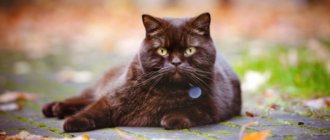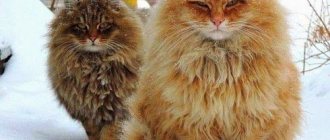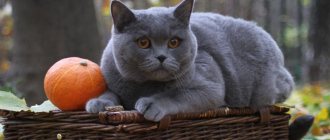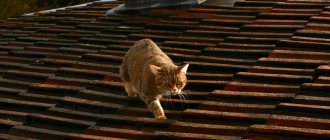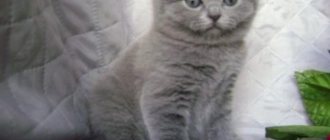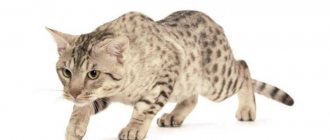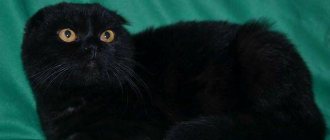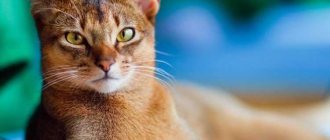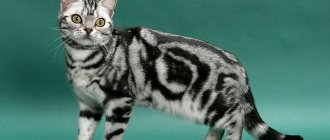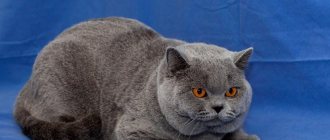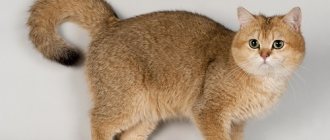The British Shorthair is one of the most popular cat breeds today. It occupies a leading place in popularity in its native country, and in Russia there is a representative of this genus in every second family.
In fact, this is a very old species of cat, the ancestors of the British appeared back in the 1st century AD. Let's take a closer look at this beautiful and ancient breed.
Here is a photo of a classic British Shorthair cat with blue color and bright orange eyes.
Description
Despite constant crossings with other breeds, the British cat has retained its main features and, according to the description, is practically no different from representatives of its breed of the last century.
The small size is more than compensated by the power and massiveness of this animal; females weigh on average 5 kg, and males 7 kg.
On the large and round head there are widely spaced round eyes, which, together with the small nose and ears, gives the British a serious appearance.
Note!
Snowshu: description and characteristics of the cat, care and maintenance- Munchkin: description and characteristics, care and maintenance of a short-legged cat
Thai cat: description and characteristics, care and maintenance, choosing a kitten
In general, they have a wide chest and good muscles. This entire stocky body is supported by short but strong legs. The tail is thick and short.
The fur of these cats is short, but very dense and fluffy, which makes them look like plush toys. There are more than 60 colors of the British Shorthair cat, but monotonous blue and lilac are considered classic.
History of the breed
The British Shorthair cat became known back in 1898, but was finally approved as a breed only 84 years later.
Such a long recognition was due to the fact that there were many complaints about the cat’s standards.
To perfect it, breeders worked a lot, crossing the best and most beautiful English domestic cats with Persians (then, after the war, with Russian Blues and Carthusian cats).
The first cat (progenitor of the British breed) is considered to be Harrison Fair.
The story of the appearance of these cats in Britain has two versions. Some claim that they were brought by legionnaires from Rome.
Others insist that the British were brought by French sailors who kept cats as excellent rat catchers.
The favorite pastime for a British cat is chasing a mouse, artificial or real, it doesn’t matter to him
Character
Generally the British are very friendly. It is impossible to force a cat of this breed to let out its claws, and if he doesn’t like something, he simply leaves, showing his disdain for the offender. It also reminds us of another striking feature - restraint.
Willfulness often manifests itself in his character. If you want to waste time, then try to force the cat to do something he doesn't want. But at the same time, the British are smart and are able to learn even the most complex commands.
Despite all the apparent indifference, these cats love their owners, and often meet them from work and lie next to them during rest. Another thing is that because of their waywardness they do not show their love so vigorously.
Note!
Bengal cat: description, characteristics and maintenance of an exotic breedNorwegian Forest Cat - description of the breed, character, habits and maintenance of the Norwegian (110 photos and videos)
- Cat litter - detailed review, prices, how to choose, where to buy
All these features make Britons ideal pets for a business person, especially since these cats are self-sufficient and can easily tolerate several days of loneliness, so you can calmly go about your business without worrying about the cat.
Maintenance and care
Adult animals are easy to care for, but the health and appearance of the pet depends on how regularly you perform caring procedures. Children and adult animals require care and attention.
The first accessories that need to be purchased before a cat appears in the house are a scratching post and a tray. It is advisable to buy an adult size “toilet” so that you don’t have to retrain a grown animal.
Pay attention to trays with high sides, as the British have a habit of digging intensely into the litter.
You will need special tweezers for trimming claws. Claws are trimmed before the animal is mated or exhibited. However, if you use the services of a specialist, he has a tool.
To comb out you will need a rubber or bristle brush. You should not use a hard accessory, as the cat's undercoat and skin may be damaged. First comb the cat along the fur, and then against it.
There is a huge selection of climbing frames, houses and cat toys on sale. The British will appreciate them.
Many cats of this breed remain playful even at an advanced age. However, the British value human attention much more. The pet happily chases a bow or a “mouse” tied to a string. You should not use foil for this: the animal will damage its teeth.
The main hygiene procedure for adult cats and kittens is careful care of the coat. The thick undercoat requires attention. British Shorthairs are prone to shedding. The cat sheds twice a year, creating some discomfort for its owners.
Brush your pet once a week between molts, and twice in winter. This is an objective necessity, since animals become very overgrown. Cats are not fans of water treatments, but washing your pet twice a year is mandatory. This is a beneficial procedure for both skin and coat. When bathing, you should protect your animal's ears from getting water.
For cats of this breed, special shampoos for soft-haired breeds are purchased. You cannot dry your cat with a hairdryer.
Another problem associated with a thick coat is that hair gets into the stomach. This is fraught with digestive disorders. Using special hair-removing pastes that cats eat with pleasure helps to avoid this problem.
Dirt and plaque from the ears and near the eyes are removed with wet wipes, cotton swabs or sponges. It is necessary to periodically inspect your pet's paws to avoid fungal infections of the claws. The British are susceptible to similar diseases.
The frequency of vaccinations is once a year. Deworming is carried out once every 3 months. One of the “anthelmintic” procedures must be carried out 10 days before vaccinations. Both manipulations should be performed only with healthy animals.
Conditions of detention
The cat is the most effective and merciless predator in nature. The British Shorthair breed has a strong hunting instinct. Therefore, if you live in a private house with a plot, the cat is incredibly lucky. He has the opportunity to walk in the fresh air and realize his hunting instincts.
Walking an animal in a city environment is necessary, but certain difficulties arise here. A cat, unlike a dog, does not require a daily walk. The pet feels great in a city apartment. However, British cats are massive, and immobility is fraught with obesity. Therefore, one way or another, care will have to be taken to expand the range. It is advisable to purchase a leash with a special harness. You cannot let your pet go outside alone. He may suffer from stray animals, and people are different.
As for climatic conditions, these cats are extremely unpretentious. If they tolerated the Italian heat and the chilly climate of Albion equally well, then there was nothing to worry about.
Before you bring your kitten home, take care of its safety. Don’t forget to install nets on the windows (preferably reinforced “anti-cat”). Make sure that all pieces of furniture are moved close to the walls (optionally, so that the kitten can walk freely). Otherwise, the baby may climb into the gap in your absence and suffocate there.
Keep all drawers and cabinets closed. Kittens are very curious, and their idea of order is different from yours. Don't forget to watch your step so you don't accidentally step on a restless baby.
Nutrition
This is a sore subject for the British, as they are big food lovers. Therefore, you will have to closely monitor your pet’s portions. You have two feeding options:
- Dry food. In this case, it is better not to skimp and buy high-quality food for your pet, so you will save a lot of money on treatment. Be sure to make sure your cat drinks enough water, or you can simply soak the food.
- Natural food. Everything here is the same as for other cats, nothing special, the main thing is don’t give anything forbidden and everything will be fine. Do not forget to periodically give your pet a vitamin complex.
Features of feeding
Contrary to the persistent stereotype, food from the human table is contraindicated for cats. This breed is no exception.
Feeding a stray animal a bowl of soup is good, but giving cutlets or fried meat to a purebred cat is, by and large, criminal. There are 2 options for pet diet: dry or natural food. You need to decide on the type of feeding right away, because as an animal grows up, it is reluctant to change its eating habits.
The advantage of dry food is its balanced composition. The cat receives a full range of nutrients.
As for the formation of a diet taking into account the weight and age of the pet, all the information is available on the packaging. If you use “drying” for feeding, you need to make sure that the cat has access to water. The class of food for purebred pets is only “premium” or “super-premium”.
It is impossible to turn feed into a savings item. Otherwise, the results of this frugality will affect the condition of the pet’s coat, its activity and general well-being. If you don’t have money to buy expensive food, you will have to use natural food.
Kitty
Up to 6 months, the number of meals per day is at least 4 times, in small portions.
The baby's diet includes:
- Meat products . Chicken, lean beef. The meat can be used boiled or raw as minced meat. To avoid worms, meat should first be frozen or doused with boiling water. Chicken by-products are useful, but they can only be given to the kitten boiled.
- Boiled sea fish : devoid of bones and fat. Fish should be given once a week, not more often.
- Fermented milk products (milk should not be given!): kefir, cottage cheese, yogurt without additives.
- Boiled chopped vegetables (carrots, zucchini, cabbage). It is advisable to mix them with meat. In its pure form, it is unlikely that a cat will eat something like this.
- Boiled chicken egg yolk or raw quail egg – once a week.
- Porridge made from buckwheat, rice and oatmeal.
To ensure that your baby enjoys eating porridge, boiled cereal is mixed in a 1:2 ratio with minced meat and tiny meatballs are made. Some time before feeding, you should remove them from the freezer.
Adult cat
A grown or adult animal is fed less often than a kitten:
- 6-8 months – three times a day.
- From 8 months – 2 times a day.
The weight of 1 serving for an adult is from 150 to 300 g, depending on the weight of the pet. The basis of the diet is meat, fish is given 1-2 times a week. An addition to the diet is porridge. Cats especially love rice. Meat products include lean beef, chicken, rabbit, veal or turkey. Products made from sour milk are healthy, but not salty and low in fat.
Cats love greenery and sometimes devour houseplants with gusto. This cannot be allowed. Firstly, they are not planted for this purpose, and secondly, the pet can be poisoned. It is much wiser to pamper your pet with lettuce, parsley and dill. You can buy a special set of grass seeds and sow your cat’s own “lawn.” Cats also love oat sprouts.
Take care of your pets, and these animals with aristocratic manners will give you many joyful moments.
Health
Since Britons are naturally bred, excellent health comes with them from birth. The only thing to be wary of are breed-specific diseases: heart disease, parasites, diarrhea, obesity, hair loss and nail fungus.
These troubles will bypass you if you monitor your pet’s health, take it for checkups and vaccinate it on time.
On average, the British live 10-15 years, some live up to 20, it all depends solely on the owners. A calm environment and a balanced diet will allow your pet to live a long and happy life.
Disadvantages and disqualifications of the British breed
Flaws
Faults are penalized at shows and reduce the total number of points. These include:
- Noticeable stop
- Lengthened or lightened undercoat, insufficient amount of it
- Soft "cotton" or lying wool
- Weak body
- Weak chin
The reasons for disqualification are:
- Wrong eye color
- Green rim around the pupil
- Long or fluffy coat
- Incorrect number of fingers (fortunately, almost never found in Russia, unlike America)
- Incorrect bite and jaw structure
- White medallion or spot
- Incorrect color of nose and/or paw pads
- Any signs of illness or illness.
Buying a kitten
Despite its popularity, this breed is expensive, the minimum price for a kitten is 7 thousand, but if you want a purebred pet with a pedigree and everything included, then you will have to find about 60 thousand rubles. Yes, this is a lot of money, but with such a pet the doors of any exhibitions will be open for you.
This breed of cat is not suitable for every person, because not everyone can get along with such a self-sufficient animal. But, if you still decide, then pay attention to the white British cat, she will amaze you with her beauty.
What you need to know about breeding
Cats of this breed reach sexual maturity at 7–8 months. The first mating cannot be planned immediately; you need to wait at least until a year and a half. It is important to select a suitable male for mating. He must be healthy, vaccinated, meet the standard and have experience interacting with cats.
British shorthair blue and lilac kittens
The date always takes place on the cat's territory. The cat is brought to visit him on the 2nd–3rd day of estrus. The first day the female looks around, gets acquainted with the gentleman, and then accepts his advances. Pregnancy in British cats lasts 62–65 days. Duration of labor is 5–20 hours. It is important to be close to your pet during the birth of kittens in order to help her if necessary.
Photo of British Shorthair cat
Differences in British Shorthair standards in different associations
If we talk about cat breed standards, European and American indicators always differ. For some breeds this is not very noticeable, and in the case of the British, a European champion often cannot even be registered as a purebred cat in America. The most detailed descriptions of standards are presented by the American felinological association CFA, but in Russian reality their exhibitions are held less frequently, so most often our animals comply with European standards (WCF and FIFe associations).
